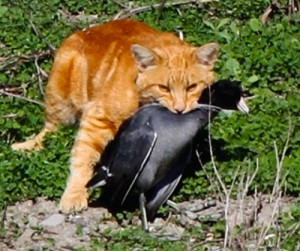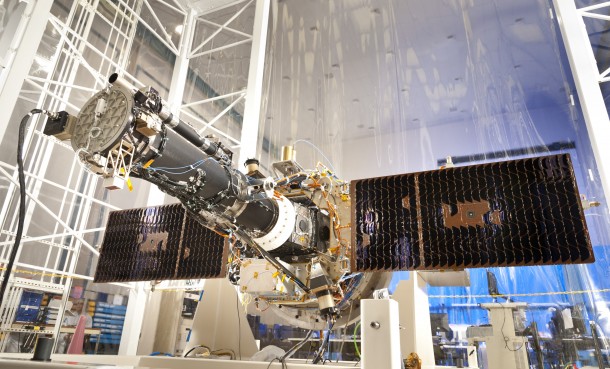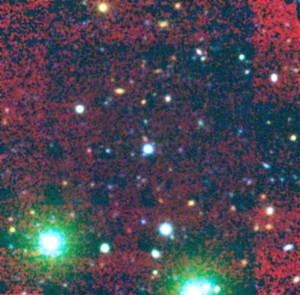When Domesticated Cats Turn Deadly

Thousands of years after first becoming domesticated, the house cat remains a beloved family pet. (Photo: Dave Morris/Flickr via Creative Commons)
Most people view cats as harmless pets, but for birds and small mammals, the domesticated feline can be a deadly killer.
A new study in Nature Communications finds bird and mammal mortality caused by outdoor cats is much higher than has been previously reported. Annual bird deaths in the United States are now estimated to be 1.4 to 3.7 billion, while mammal mortality runs from 6.9 to 20.7 billion individual animals.
Stray cats, as opposed to those that are owned and cared for by humans, cause the majority of these deaths, according to researchers from the US Fish and Wildlife Service (FWS) and the Smithsonian Conservation Biology Institute, who conducted the study.
The study, by two of the world’s leading science and wildlife organizations, offers the one of the most comprehensive analyses on outdoor cat predation.
The ancient Egyptians may have been the first to domesticate the cat more than 4,000 years ago. The animal became a favored household pet over the centuries, in large part due to their natural ability to hunt and eradicate household pests and vermin, such as mice and rats.
But that natural hunting ability could be a key reason cats are listed as one of the 100 worst non-native invasive species in the world, according to the Global Invasive Species Database, which was published in 2000.

A cat with its catch, a bird called the American Coot (Photo: Debi Shearwater)
A separate 2011 study found free-ranging cats have caused or contributed to 14 percent of modern bird, mammal and reptile extinctions on islands. The same report also found that feral cats cause a substantial proportion of total wildlife mortality.
Dr. George Fenwick, president of American Bird Conservancy, a group which has called for action on this issue for many years, reacted to this latest report. “This study, which employed scientifically rigorous standards for data inclusion, demonstrates that the issue of cat predation on birds and mammals is an even bigger environmental and ecological threat than we thought. No estimates of any other anthropogenic [human-caused] mortality source approach the bird mortality this study calculated for cat predation.”
However, the Humane Society of the United States questioned the report’s numbers. “The HSUS values both cats and wildlife. There is a legitimate issue with free-roaming cats preying on birds and other wildlife, and we are working to change that in a meaningful way,” said Wayne Pacelle, president and CEO of the Humane Society of the US. “Despite the scientific rigor with which this report was prepared, like others recently published, it tries to attach a number to something that is almost impossible to credibly quantify.”
The larger issue, according to the humane society, is finding practical and humane actions to mitigate the impact of cats in communities.
Current policies for managing feral cat populations and regulating pet ownership usually focus more on animal welfare rather than ecological impacts, according to authors of the latest study.

The domesticated cat’s natural hunting abilities help homeowners keep their homes pest and vermin free. (Photo: Cobalt123/Flickr via Creative Commons)
One of the more popular forms of managing free-ranging cats includes Trap-Neuter-Vaccinate and Return colonies, a method of humanely trapping feral cats, spaying or neutering them as needed, vaccinating the animals for diseases like rabies, and then releasing them back to the same location where they were collected.
The study asserts these methods of managing feral cats are employed throughout the US without widespread public knowledge, consideration of scientific evidence, or the environmental review processes typically required for actions with harmful environmental concerns.
The researchers recommend scientifically sound conservation and policy intervention to reduce the negative impact of feral cats on wildlife.
Study Finds Energy Use in Cities Causes Winter Warming

Waste heat from major cities is contributing to warmer winters, according to a new study. (Photo: Petr Magera via Creative Commons at Flickr)
Everyday energy consumption in urban areas could be significant enough to cause winter temperatures to rise.
According to a new study funded by the US National Oceanic and Atmospheric Administration (NOAA), waste heat released in major cities in the Northern Hemisphere in the northern-most parts of North America and Eurasia.
“The world’s most populated metropolitan areas, which also have the highest rates of energy consumption, are along the east and west coasts of the North American and Eurasian continents, underneath the most prominent atmospheric circulation troughs and ridges,” said Ming Cai, from Florida State University and an author of the study. “The concentrated and intensive release of waste energy in these areas causes a noticeable interruption to normal atmospheric circulation systems, leading to remote surface temperature changes far away from the regions where the waste heat is generated.”
According to the study published Nature Climate Change, the total amount of energy consumed throughout the world in 2006 was 16 terawatts, 16 trillion watts with 6.7 terawatts of that amount consumed within the 86 metropolitan areas considered in the study.
“The burning of fossil fuel not only emits greenhouse gases but also directly effects temperatures because of heat that escapes from sources like buildings and cars,” said Aixue Hu of the National Center for Atmospheric Research in Boulder, Colorado, another of the study’s authors.
The excess energy and resulting warmer winter temperatures could also help explain the discrepancies between actual observed warming over the last half-century, compared to the amount of warming that computer models have been able to account for.

US National Weather Service illustration of two atmospheric systems known as jet streams traveling northeast across the United States. (NOAA)
Waste heat from urban areas is different from energy found naturally in atmosphere, such as what’s produced by our Sun-warmed planet. That atmospheric energy is normally distributed from one region to another by various circulation systems, like the Jet Stream.
Humans consume energy produced by fossil fuel sources, oil and coal, that have stayed hidden and unused for millions of years. Although the amount of energy produced and used by humans represents only a small portion of what’s actually transported throughout the atmosphere by nature, the researchers say that it is highly concentrated in urban areas.
“What we found is that energy use from multiple urban areas collectively can warm the atmosphere remotely, thousands of miles away from the energy consumption regions,” said study co-author Guang Zhang, from Scripps Institution of Oceanography. “This is accomplished through atmospheric circulation change.”
The influence of heat generated in urban areas can widen the jet stream and strengthen atmospheric flows in regions located at mid-latitudes, areas which lie between the tropics and the polar regions of the world.
Researchers point out this warming effect generated by urban heat is not necessarily even and uniform throughout the world. They say changes in major atmospheric systems, that can cool parts of Europe by up to 1 degree C mostly during the fall, can offset this heating effect. That’s why the impact of the urban winter heat on global temperatures is slight, raising the temperature by an average of about .1 degree C worldwide.
The study does not address whether the effects of urban heating can actually disrupt atmospheric weather patterns or if it plays any role in hastening global warming.
Science Images of the Week

Artist’s concept of a new view of the Milky Way. Scientists have discovered the Milky Way’s elegant spiral structure is dominated by two arms wrapping off the ends of a central bar of stars. Our galaxy was previously thought to possess four major arms. (NASA)

Native to Madagascar, this is an indri, one of the largest living lemurs in the world. (Meredith Barrett)

This is a Spallation Neutron Source cavity assembly in the clean room the Thomas Jefferson National Accelerator Facility in Virginia. It’s a piece of a particle accelerator scientists use to provide the most intense pulsed neutron beams in the world. (Jefferson Lab)

NASA will use this spacecraft, seen here with its solar panels deployed in a clean room at Lockheed Martin in Sunnyvale, California, for its Interface Region Imaging Spectrograph (IRIS) mission scheduled for launch this April. (Lockheed Martin)

Immune system cells, called macrophages, normally engulf and kill intruding bacteria but sometimes the microbes, shown in red, find a way to escape into the interior of the cell where it can multiply and invade other cells. (Miao lab, UNC School of Medicine)

A large male purple marsh crab (Sesarma reticulatum) clips cordgrass with its claws. These crabs are nocturnal and typically live in burrows during the day to stay moist and avoid predators. (Tyler Coverdale)

This is a single five-minute exposure taken recently in Buenos Aires on an Argentinian summer night. It shows not only Earth clouds but starry clouds, the pinkish glow of the Carina Nebula and Small Magellanic Clouds. The line arcing from the center of the right side to the lower left is the orbiting International Space Station. (Photo & Copyright: Luis Argerich)

Before workers with NASA’s US Antarctic Program are sent into the field, they must first undergo training to endure the harsh Antarctic conditions. Here’s a look at their training camp site, set up on the Ross Ice Shelf ,the largest ice shelf of Antarctica. ( NASA)

Found in the waters surrounding the Philippines, a moray eel poses for a photo. (M. J. Costello)
NIH Urged to Retire Lab Chimps

Electrodes are placed on the head of lab chimpanzee Mizuki for brain wave measurement. (NIH)
An advisory group has called on the National Institutes of Health (NIH) to retire most of the nearly 700 chimps it owns or supports.
NIH’s Council of Councils also recommended the medical research agency drastically cut back on the various medical studies involving the use of chimpanzees, while making certain those chimps that are still being studied are kept in proper living conditions.
The recommendations, contained in an 84-page report, were in response to a December 2011 review by the Institute of Medicine (IOM), which concluded that while the chimpanzee was a valuable animal model in the past, most current biomedical use of the animal is unnecessary.
The IOM suggested that while chimpanzees could still serve an important role in some research areas, a set of guidelines, principles and criteria must be established to govern that research.

Chimpanzees that had been used for NIH biomedical testing get acquainted with their new retirement home at Chimp Haven in Louisiana. (AP)
Using the IOM report for guidance, NIH’s advisory group recommended the majority of NIH-owned chimpanzees be retired and transferred to facilities within the federal sanctuary system, while immediately planning to ensure proper accommodations and treatment for the chimps.
The advisory group suggested a small population of about 50 chimpanzees be maintained by the agency for future potential research as long it meets the principles and guidelines contained within the IOM report.
The report stressed that animals remaining in NIH custody should be kept in “ethologically appropriate” settings, which include large, complex social groups, year-round outdoor access and more than 1,000 square feet of living space per chimpanzee.
The size and placement of this colony, according to the NIH group, should also be reassessed about every five years to ensure a colony of chimps is still needed and that the animals aren’t overused.
With fewer chimpanzees being made available to scientists for research, the advisory group recommended NIH to encourage and support the development and refinement of other approaches, especially alternative animal models, such as genetically altered mice, for research on new, emerging and reemerging diseases.

A chimpanzee named Lyons sits in a play yard at Chimp Haven in Keithville, La. (AP)
The new recommendations follow last month’s NIH decision to move all 100 of the federally-owned chimpanzees at the New Iberia Research Center in Louisiana to Chimp Haven, a federal chimpanzee sanctuary in nearby Keithville, Louisiana, over the next 12 to 15 months.
A leading animal rights group praised the recommendations.
“The Humane Society of the United States is extremely pleased that these experts confirm what the public has been urging: move away from invasive chimpanzee experimentation and release these animals to the most appropriate setting available – sanctuary,” said Kathleen Conlee, vice president of animal research issues at the Humane Society. “There are top-notch sanctuaries in the U.S., including federal sanctuary Chimp Haven, that have the capacity to expand and we are ready to work with the government to provide these chimpanzees with the retirement they so greatly deserve.”
The NIH will make a final determination on the recommendations after a 60-day public comment period that begins today and runs until March 23, 2013.
For Obese Kids, Serious Health Issues Can Start Early

Children with a BMI in the 95th percentile are at risk for serious health problems, according to a new report. (Photo: Robert Lawton via Wikimedia Commons)
Obese children face many more immediate health issues and are at increased risk for medical, mental and developmental problems than was previously thought, according to a new report.
The study based on UCLA research found that obese children – those with a Body Mass Index (BMI) in the 95th percentile or above – are nearly two times more likely to have three or more physical or mental conditions than kids with a healthy weight.
Overweight children – those with a BMI in the 85th to 95th percentile – had about 1.3 times higher risk of developing adverse health conditions.
While most previous research focused on long-term health problems which could develop during adulthood, this study looked at the immediate consequences of childhood obesity.
The findings were based on information taken from a much wider and larger sample of participants than previous similar studies, according to researchers. Fifteen percent of the children studied were considered to be overweight and 16 percent were obese.
Compared to their normal-weight peers, obese children were more likely to be in poorer health, have more disabilities and more emotional and behavioral problems, such as having to repeat a grade, missing school and other educational difficulties.
Children classified as obese were also more likely to have conduct disorders, depression, learning disabilities, developmental delays as well as physical ailments such as bone, joint and muscle problems, allergies, headaches, asthma and ear infections.
“This study paints a comprehensive picture of childhood obesity, and we were surprised to see just how many conditions were associated with childhood obesity,” said lead author Dr. Neal Halfon, a UCLA professor who directs the Center for Healthier Children, Families and Communities. “The findings should serve as a wake-up call to physicians, parents and teachers, who should be better informed of the risk for other health conditions associated with childhood obesity so that they can target interventions that can result in better health outcomes.”
The World Health Organization (WHO) considers childhood obesity to be “one of the most serious public health challenges of the 21st century.” In 2010, the WHO found there were more than 42 million children under five worldwide who are overweight. Close to 35 million of those children live in developing countries.
Scientists Discover Universe’s Largest Known Structure

Artist’s impression of a very distant quasar powered by a black hole with a mass two billion times that of the Sun. (Image: ESO/M. Kornmesser via Wikimedia Commons)
Scientists have found the largest known structure in the universe, a cluster of galactic cores so vast it would take four billion years for a spacecraft traveling at the speed of light to cross it.
The sighting challenges a theory from Einstein which suggests such a massive object shouldn’t exist in the universe.
A quasar is the compacted center of a galaxy surrounding a massive black hole from the early days of the universe. Quasars go through periods of extreme brightness which can last anywhere from 10 to 100 million years. They tend to band together in enormous clusters, or structures, forming large quasar groups (LQGs).
The international group of scientists led by Roger Clowes from the University of Central Lancashire’s Jeremiah Horrocks Institute, used data from the Sloan Digital Sky Survey (SDSS), a major surveying project that uses 2.5-m wide-angle optical telescope located at New Mexico’s Apache Point Observatory, to make their findings.
Clowes and his colleagues are astounded by the size of this structure, which defies the Cosmological Principal, based on Albert Einstein’s theory of General Relativity that assumes when you look at the universe from a sufficiently large scale; it looks the same no matter where you are observing it from. The Cosmological Principle, according to the research team, is assumed but has never been demonstrated observationally ‘beyond reasonable doubt.’

Large quasar group (LQG) as imaged by the Big Throughput Camera at the Cerro Tololo Inter-American Observatory in Chile (Photo: Chris Haines)
“While it is difficult to fathom the scale of this LQG, we can say quite definitely it is the largest structure ever seen in the entire universe,” said Clowes. “This is hugely exciting, not least because it runs counter to our current understanding of the universe. The universe doesn’t seem to be as uniform as we thought.”
Clusters of galaxies can be anywhere from six to 10 million light-years across, but the LQGs can be 650 million light-years or more across. Making calculations based on the Cosmological Principle, along with the modern theory of cosmology, astrophysicists shouldn’t be able to find a structure in the universe larger than 1.2 billion light-years, much less four billion light-years across as this newly sighted structure is.
To get some additional perspective of what the astronomers found, let’s step back and give it a sense of scale. Our own galaxy, the Milky Way, is separated from its nearest neighbor, the Andromeda Galaxy, by a distance of 2.5 million light-years.
Clowes points out that his team’s discovery does have a typical dimension of 1.6 billion light-years. But, because it is elongated, its longest dimension is four billion light-years, making it about 1,650 times larger than the distance from the Milky Way to Andromeda.

The first Apple iPhone was introduced on January 9, 2007 and went on sale in June 2007. Here’s the original iPhone sitting in it’s charging dock. (Photo: Andrew via Wikimedia Commons)
On Wednesday, January 9, the iPhone turned 6 years old. On that day in 2007 Apple’s late visionary leader Steve Jobs took the stage at the Macworld Expo in San Francisco to address the Apple faithful about a new and highly anticipated product the company was unveiling.
Describing it as a “leap frog product that is way smarter than any mobile device that has ever been and super easy to use,” Jobs introduced the first iPhone to the world.
It wasn’t the very first smartphone – some in the communications industry credit IBM’s Simon Personal Communicator released in 1994 as the first – nor was it the only smartphone on the market at the time – in 2007, Blackberry and Palm devices were all the rage. But the release of Apple’s iPhone really caught the public’s attention and took the smartphone further into the mainstream with its advanced technology and multi-function abilities.
Apple boasted about the capabilities of its new device saying at the time that the iPhone combined three products into one—a new type of mobile phone, a widescreen iPod with touch controls, and an innovative Internet communications device that provided desktop-like email, web browsing, searching and maps.

People wait in line at an Apple Store, in Salt Lake City Utah, to be among the first to get their hands on the new iPhone 5 on Sept. 21, 2012. (Photo: AP)
Between its introduction in January and its release in June 2007, excitement took hold with the iPhone quickly becoming the “must have” device weeks before it even was put on sale. The iPhone became an instant hit with consumers selling over a million devices within its first 74 days on the market, according to Apple.
In the years since, Apple has released newer versions of the iPhone that gave its users even more functionality. One of the most popular new features included the 2011 introduction of “Siri” in its iPhone 4S. Apple described Siri as “an intelligent assistant that helps you get things done just by asking.” Siri interacts and communicates with the user through normal speech: a user just asks Siri a question and “she” answers back via a synthesized voice.

The first smartphone powered by the Android system was the HTC Dream that first went on sale in October 2008 (Photo: Marcus Sümnick via Wikimedia Commons)
While Apple has sold millions of iPhones over the years, the popular smartphone has not been without its critics. For example, when it was first released in the US, Apple had an exclusive agreement with AT & T wireless, meaning the much coveted iPhone could only work on the AT & T wireless system. This arrangement didn’t sit too well with a lot of US consumers, saying it severely limited their choice of wireless carriers to just one. Other complaints about the iPhone since its initial release have included various difficulties that users had in operating the device or about a number of glitches or problems with issues such as software updates or the phones themselves.
As with any successful product, it didn’t take long until Apple competitors like Samsung, HTC, LG and others quickly sprang into action to develop and release their own advanced mobile devices they hoped would dethrone the iPhone as the most popular smartphone.
Despite the release of several imitators, Apple’s iPhone continued its reign as the top smartphone. But dark clouds were forming in the horizon for Apple as word of a new mobile phone operating system began to spread. The web-search engine giant Google had been talking about getting into the mobile telecommunications market since its 2005 acquisition of Android, Inc.; the company that designed and developed the new mobile device operating system. The buzz on the street at the time indicated that the new Android operating system just might be more advanced and superior to what Apple was running on its iPhone.

The popular Android powered Samsung Galaxy S III smartphone. (Photo: Superzen via Wikimedia Commons)
The Android operating system was unveiled in November 2007; just five months after the first iPhones went on sale. The first mobile phone powered by the Android system, the HTC Dream, was released in October 2008.
Google offered the Android system with an open source code and a somewhat lenient licensing arrangement, making it much easier for software that would run on the Android system to be written, modified and distributed.
So far, according to recent research statistics, about 700,000 software applications or “apps” have been developed for mobile devices running on the Android system. But, Apple continues to lead Android with a reported 1,000,000 apps developed for the iPhone.
The Android powered Samsung Galaxy S III and Apple’s iPhone 4S are two of the most popular smartphones being sold today.
The fight for market domination among smartphone manufacturers continues to fuel research and development of even much more advanced and sophisticated mobile devices.
Milky Way Contains Billions of Earth-sized Planets, Studies Find

One out of every six stars in our Milky Way galaxy has an Earth-like planet orbiting it, according to two new studies. (Photo: Steve Jurvetson via Wikimedia Commons)
There are at least 17 billion Earth-sized worlds in our Milky Way galaxy, according to two new studies.
Both groups of scientists used data from NASA’s Kepler mission to reach their conclusions, which were presented to the American Astronomical Society in Long Beach, California.
The scientists found that the closer the planets are to their stars, the easier they are to find because they transit more frequently, giving scientists more opportunities to observe them.
One group, led by Francois Fressin of the Harvard-Smithsonian Center for Astrophysics (CfA), said its studies show 50 percent of stars in our galaxy have a planet the size of Earth or larger closely orbiting them.
Add in larger planets, which have been found to be in wider orbits around its star, and the percentage of stars with planets goes up to 70 percent, according to the researchers.
Based on current ongoing observations from the Kepler mission, along with others using different detection techniques, it looks like practically all Sun-like stars have planets, according to the Harvard-Smithsonian team.
A second group of researchers, from the University of California, Berkeley and the University of Hawaii at Manoa, found smaller exoplanets to be much more plentiful than larger ones in the star systems it observed. The analysis also confirmed that the frequency of planets increased as its size decreased, which team member Andrew Howard and the Kepler team reported last year.
Perhaps one percent of stars have planets the size of Jupiter, while 10 percent have planets the size of Neptune, according to the Berkeley/ Hawaii team. The group’s research also shows the exoplanets they observed, which were two or three times the diameter of Earth, are typically more like our solar system’s Uranus and Neptune, each of which has a rocky core surrounded by helium and hydrogen gases and, perhaps, water.

Artist’s conception of the wide variety of planets detected by NASA’s Kepler spacecraft. (C. Pulliam & D. Aguilar/CfA)
They suggest planets orbiting close to their stars may even be water worlds, with oceans hundreds of kilometers deep, surrounding a rocky core.
Although the planets between one to two times larger than Earth may not necessarily be habitable, the Berkeley/Hawaii team said those planets might be rocky and, if they’re located within what they call the “Goldilocks zone” –not too hot, not too cold, just right for liquid water– could support life.
The Harvard-Smithsonian researchers found that, except for the gas giants, the type of star didn’t really have much effect on the size of its planets, contradicting previous findings. Neptune-type planets, they said, can be found just as frequently orbiting around relatively cool stars, called red dwarfs, as they are around sun-like stars. The same is true for smaller worlds.
“Earths and super-Earths aren’t picky,” said Guillermo Torres of the Harvard-Smithsonian team. “We’re finding them in all kinds of neighborhoods.”
As more data is gathered, more planets in larger orbits will be revealed, according to the Harvard-Smithsonian researchers. They say when Kepler’s mission is extended, astronomers should be able to spot Earth-sized planets at greater distances, including those with Earth-like orbits within the habitable zone.
Mars Meteorite Sparks New Questions About Red Planet

The Martian meteorite known as “Black Beauty” weighs approximately 320 grams. (Carl Agee/University of New Mexico)
Scientists have determined a meteorite discovered in the Sahara Desert in 2011 is about 2.1 billion years old and could be the first meteorite to come from the surface of Mars.
The meteorite, designated NWA (North West Africa) 7034 and nicknamed “Black Beauty,” weighs about 320 grams and is loaded with Martian water. It is so uniquely different from other Martian meteorites that scientists say it is in a class of its own.
They believe Black Beauty, which contains 10 times more water than other Martian meteorites from unknown origins, formed during the beginning of the most recent geologic period on Mars, known as the Amazonian.
“The age of NWA 7034 is important because it is significantly older than most other Martian meteorites,” said Mitch Schulte, program scientist for the Mars Exploration Program at NASA headquarters in Washington. “We now have insight into a piece of Mars’ history at a critical time in its evolution.”
The NASA-funded team of scientists from various universities and institutions analyzed the mineral and chemical composition, age, and water content of the meteorite.
Black Beauty’s chemical composition includes organic carbon, which is similar to other Martian meteorites, known as SNC meteorites. However, other aspects of Black Beauty’s composition are very different.
“The texture of the NWA meteorite is not like any of the SNC meteorites,” said Andrew Steele, who led the carbon analysis at the Carnegie Institution’s Geophysical Laboratory. “This is an exciting measurement in Mars and planetary science. We now have more context than ever before to understanding where they may come from.”
Black Beauty, according to the research team, is made of cemented fragments of basalt, rock formed from rapidly-cooled lava. The fragments are primarily feldspar and pyroxene, most likely from volcanic activity.

Scientists say the Black Beauty meteorite came from the surface, or crust, of Mars (NASA)
“This Martian meteorite has everything in its composition that you’d want in order to further our understanding of the Red Planet,” said Carl Agee, leader of the analysis team and director and curator at the University of New Mexico’s Institute of Meteoritics in Albuquerque. “This unique meteorite tells us what volcanism was like on Mars two billion years ago. It also gives us a glimpse of ancient surface and environmental conditions on Mars that no other meteorite has ever offered.”
Up until now, SNC meteorites have been the only meteorite samples from the Red Planet scientists have been able to study, however, their exact point of origin on Mars isn’t known. Scientists say recent data from NASA Mars lander and orbiter missions indicate the SNC meteorites are actually a mismatch with the Martian crust.
But Black Beauty does match up with surface rocks and outcrops studied by NASA’s Mars rovers, such as Curiosity, Opportunity and Spirit, as well as its orbiting satellites, like the Mars Odyssey Orbiter.
“The contents of this meteorite may challenge many long-held notions about Martian geology,” said John Grunsfeld, associate administrator for NASA’s Science Mission Directorate in Washington. “These findings also present an important reference frame for the Curiosity rover as it searches for reduced organics in the minerals exposed in the bedrock of Gale Crater.”
Alan Alda’s Challenge to Scientists

Professor Alan Alda (Photo: Center for Communicating Science, Stony Brook University)
Alan Alda, the internationally famous TV/movie actor, director and writer, is looking for answers to a question we’ve all pondered at some point in our lives – what is time? So he recently issued a challenge to the world’s scientists to come up with a good explanation.
While the question alone might stump even the brightest of scientists, Alda’s challenge also has a catch. The explanation must be made so that an 11-year-old can easily understand it.
Science World recently spoke with Alan Alda to learn more about his challenge. He told us that when he was just 11 years old, he found himself becoming quite fascinated with the flame burning at the end of a candle.
Curious about what a flame was, Alda decided to ask his teacher – “what’s a flame?” He was hoping for a clear and concise answer to his question, but the teacher instead came back at him with just a one word answer – oxidation.
Needless to say, young Alan was quite dissatisfied with his teacher’s answer and was frustrated that he still didn’t know what a flame was.
In spite of the teacher’s terse answer to his query, Alda continued to have a lifelong interest in science.
While he’s best known for playing the wisecracking surgeon Dr. Benjamin “Hawkeye” Pierce, M.D. on the classic TV show M*A*S*H, Alda also hosted the TV series “Scientific American Frontiers” that aired on the U.S. public television network PBS.
Throughout the course of hosting that TV show, Alda said that he had the chance to interview hundreds of scientists. In doing so, he discovered that many of the scientists he spoke with had wonderful stories to tell, but some needed help in telling them.
Alda also concludes that the scientists themselves are recognizing that they need to become better communicators, and that there are three big groups of people that need to be communicated with better.

What is time??? (Image: The Flame Challenge/Center for Communicating Science, Stony Brook University)
The first group is the general public. Alda says the public needs to have a clear understanding of science because they’re using it every day. And because they may not quite understand it, he says people aren’t asking the right questions and sometimes that creates barriers to better science.
The second group of people, according to Alda, includes legislators and policy makers. “They routinely don’t understand what the scientists are asking funding for; they don’t understand it at a deep enough level anyway,” he said.
The third group that Alda said can really benefit from better science communication is that of fellow scientists — those who sometimes aren’t familiar with scientific disciplines other than their own. “So that’s holding back collaboration, I would think, holding back new inroads that can be made because an awful lot of things happening now, that are breaking ground, require the collaboration of a lot of people from a lot of different fields,” Alda said.
So to help scientists and health professionals develop the skills needed to become effective communicators, Alda helped create the Center for Communicating Science at Stony Brook University in New York, where he is also a visiting professor.
His passion for communicating science to others also came through while writing a guest editorial for the journal Science.
“I realized that I had a personal story to tell about communicating science and it was that story about my teacher not really explaining the flame very well. And then I realized by the end of the article that I had a contest and I challenged scientists to come up with an explanation an 11-year-old could understand.”
![Alan_Alda_MASH_1972 1972 photo of Alan Alda as the wisecracking but loveable Dr. Benjamin "Hawkeye" Pierce" on the TV series M*A*S*H. (Photo: CBS Television [Public domain], via Wikimedia Commons)](//blogs.voanews.com/science-world/files/2013/01/Alan_Alda_MASH_1972-225x300.jpg)
1972 photo of Alan Alda as the wisecracking but loveable Dr. Benjamin “Hawkeye” Pierce on the TV series M*A*S*H. (Photo: CBS Television [Public domain], via Wikimedia Commons)
From over 800 entries submitted, 31-year-old Ben Ames, an American studying for his Ph.D in Austria, won the first “Flame Challenge” last year with his animated video explanation of “What is a flame?”
A couple of weeks ago, Alda issued his second “Flame Challenge.” The question this time came from actual 11 year-old students. Like the first “Flame Challenge” question, this one also is very basic – but it’s also quite perplexing and one that might be difficult for scientists to explain to the young students. The question: “What is time?”
According to the “Flame Challenge” website, entries can either be written, or in video or graphic forms.
Scientists competing in the “Flame Challenge” have till 0459 UTC March 2, 2013, to get their entries in. The judging will be done by thousands of 11-year-olds.
Alda says that judging the contest has been a big hit with the young scientists of the future. “They really love the chance to take a serious position in deciding what’s a good explanation and they are very serious about it,” he said.
While the “Flame Challenge” question alone could be difficult to answer, why does the explanation have to be understood by 11-year-olds in particular?
“It just happened that way, because I was 11 when I asked that question,” explained Alda. “It turns out that, as we look at 11-year-olds who are judging it, it seems they have a kind of special ability, they’re in a special place in their lives where they still have the curiosity, a sort of unbridled curiosity of a kid, but they’re beginning to take on the critical thinking of an adult, so they’re in a good position to both asked the question and judge the answer,” he said.

Professor Alda helps scientists communicate more effectively. (Photo: Center for Communicating Science, Stony Brook University)
Videos of the youngsters reviewing answers that were submitted for last year’s challenge revealed just how serious they were about their judging duties. “They say things like, ‘this is too short, it doesn’t have enough information,’” Alda said. “And one kid was great, he said that ‘we like them if they’re entertaining, but this is silly.’ He said that ‘We’re 11, not seven,’ and I loved that very grown up approach to this old question.”
Schools around the world can also take part in the “Flame Challenge” by getting their 11-year-old students involved with judging.
For details on how scientists can take on the challenge, and how 11-year-olds can become judges, just visit the “Flame Challenge” website.
Alan Alda joins us this weekend on the radio edition of Science World. He talks about the “Flame Challenge” and why it’s important for scientists to be good communicators. For broadcast times please check the right column.
You can listen below to hear the full Science World interview with Alan Alda.
[audio://blogs.voanews.com/science-world/files/2013/01/Science_World_-_One_On_One_-_Alan_Alda_-_Communicating_Science_-__FULL_VERISION-32b.mp3|titles=Science World – Alan Alda – The 2013 Flame Challenge]































![Alan_Alda_MASH_1972 1972 photo of Alan Alda as the wisecracking but loveable Dr. Benjamin "Hawkeye" Pierce" on the TV series M*A*S*H. (Photo: CBS Television [Public domain], via Wikimedia Commons)](http://blogs.voanews.com/science-world/files/2013/01/Alan_Alda_MASH_1972-225x300.jpg)




















